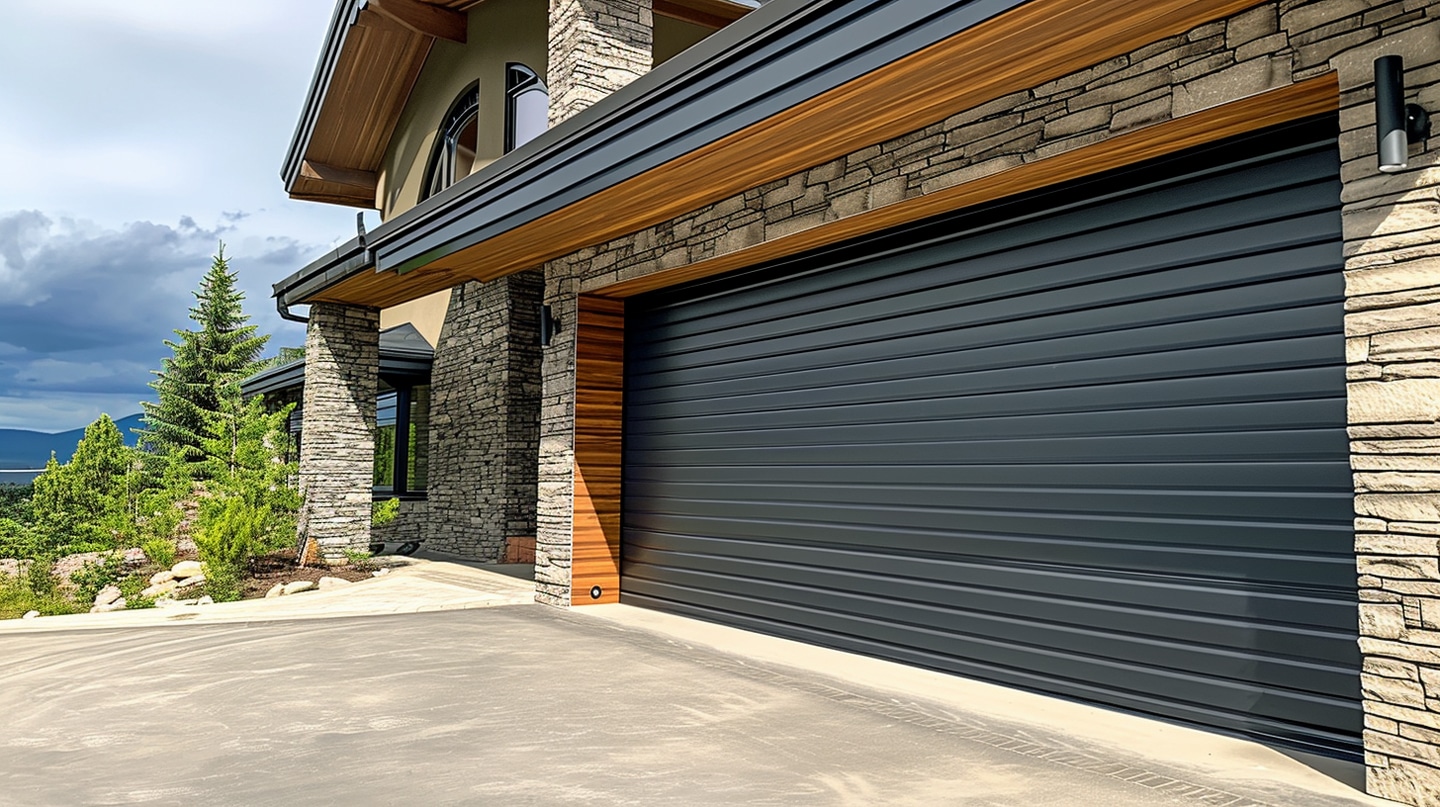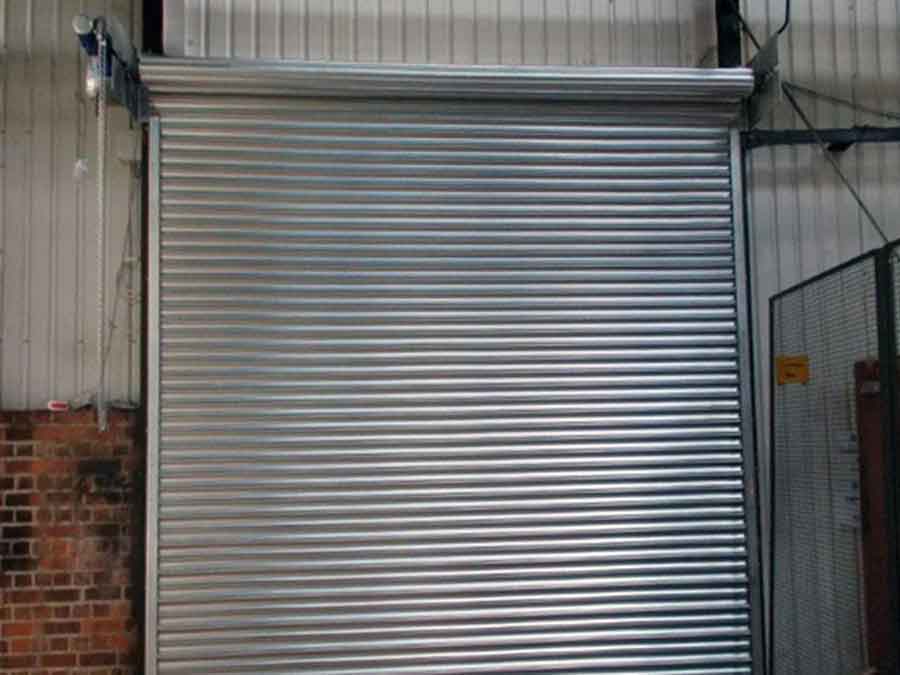In this article, I’ll show you something totally different from the typical garage doors you’ll find from many garage door manufacturers: a residential roll-up garage door.
I used to think that sectional garage doors were the only type of garage door you could buy for your home. Except for the retro-style, one-piece wooden doors on homes from the 1960s, it was all I saw in my neighborhood.
It wasn’t until much later that I discovered they made industrial, roll-up garage doors for residential homes. This is similar to a commercial overhead door but with a few tweaks explicitly designed for residential homes.
In this article, I’ll tell you everything you need to know about residential roll-up doors so you can decide if its right for your home.

Sectional vs. Roll-up Garage Doors
Let’s start with a brief comparison between sectional garage doors and roll-up doors.
What Are Sectional Garage Doors?
You’re probably already familiar with sectional garage doors. They’re made from large panels that join together to form a solid barrier when closed.
Vertical tracks run alongside your garage door, connected to long, horizontal tracks on the garage ceiling. When you open and close the door, sections of the garage door slide along the track to move it up and down.
The drawback to this design is that sectional garage doors take up much space at the top of your garage when they’re open.
That means you can’t use that area for overhead garage storage. It also blocks any ceiling lights above it when it’s open.
Also, since it’s exposed to the elements, you must regularly lubricate and maintain a sectional garage door.
You can replace individual panels on a sectional garage door. For example, if your kids hit it with their bicycles,
That’s a lot cheaper than replacing the entire door.
You can buy sectional doors with glass or acrylic windows to let light into your garage.
Finally, the biggest advantage to many people is that sectional garage doors come in a wide variety of colors and designs that can match the exterior of your home.

What Are Roll-Up Garage Doors?
Roll-up doors are also called rolling or roller doors, similar to heavy-duty commercial doors in industrial warehouses.
Lately, they’re becoming popular for residential homes.
They’re lightweight and easier to install than traditional garage doors. Roll-up doors are typically made from corrugated, galvanized, or stainless steel sheets but can sometimes be made from aluminum.
When you open a roll-up door, it winds into a compact roll at the door opening, which doesn’t block any garage ceiling lights you may have.
Best of all, roll-up doors don’t need tracks across the ceiling, which opens up much more space in your garage than typical sectional garage doors.
Their simple design reduces the potential for mechanical or electrical problems. Even if a roll-up garage door costs the same as a conventional sectional door, it usually costs you less in the long run due to lower maintenance.
Some designs have even achieved wind load certification, making them viable products for hurricane-prone locations like Florida.
One of the disadvantages of roll-up doors is that they only come in a few different colors and styles. Matching them to your home’s exterior paint is more challenging because there are fewer color options than sectional doors.
Finally, if part of the door gets dented or damaged, you’ll need a new pre-assembled industrial door.
There’s no such thing as a partial replacement of residential roll-up doors.
Pros & Cons of Residential Roll-Up Doors
Here are some advantages and disadvantages to residential roll-up doors.
Pros:
- Space-saving design: Roll-up doors are perfect for garages with limited space as they roll up vertically, saving valuable ceiling and wall space.
- Enhanced security: Made from robust materials, roll-up doors offer better protection against break-ins and external elements.
- Durability: Roll-up doors are designed to withstand heavy use and are less prone to dents and damage.
- Smooth operation: With the option of motorized openers, roll-up doors provide convenient and effortless operation with the touch of a button.
- Insulation options: Some roll-up doors come with insulation features, helping to regulate temperature and reduce energy costs.
Cons:
- Higher upfront cost: Roll-up doors generally have a higher initial cost compared to traditional doors, primarily due to their construction and materials.
- Limited design options: Roll-up doors are often available in a more limited range of styles and designs compared to other garage door types. Typically, roll-up garage doors are available in black or white, only.
- Professional installation required: Due to their complex nature, installing roll-up garage doors typically requires professional assistance.
- Maintenance: While roll-up doors are durable, they may require periodic maintenance, such as lubrication and adjustment, to ensure smooth operation.
Residential Roll-up Garage Door Sizes
While sectional garage doors usually come in only a few standard sizes, roll-up garage doors can come in many different sizes.
Sectional garage door sizes vary slightly depending on where you live. In general, a door for a single car measures 8′ or 9′ wide by 7 feet tall. If you’re looking at a double garage door, they measure 16′ wide by 7′ high.
If you want something larger, choose a custom build, which will quickly increase the cost. Custom doors typically max out at 16′ wide and as tall as 10’-12′.
However, roll-up garage doors come in a more flexible array of sizes because of how they’re built.
They usually start at 7′ by 7′, which works for a small storage shed or a motorcycle garage. However, that can reach up to 20′ wide (or wider) by 18′ high, which is enough for industrial or commercial buildings that house heavy equipment or construction vehicles.
With such a wide size range, it’s easy to customize roll-up doors to fit any residential garage door opening.
Who Makes Residential Roll-Up Garage Doors?
There are several manufacturers of residential roll-up garage doors in the US, such as:
- Roll Up Doors Direct: Roll Up Doors Direct is a company based in Groveland, FL, that sells and installs various types of roll-up doors for residential and commercial use. They also provide features such as certified wind-load-rated doors, 26 gauge steel curtains, and insulated doors.
- LUX Garage Doors: Lux Garage Doors is a company that sells a variety of premium garage door styles, including residential roll-up doors. They also sell door hardware, wood floors, and lighting products.
Are Residential Roll-up Garage Doors Insulated?
Here in Florida, my garage was unbearable in the summer until I added a garage door insulation kit. Many of you have told me you have the same challenge, only in the winter.
If you use your garage for a workshop or home gym, you don’t feel like doing anything when it’s that uncomfortable.
Fortunately, you can get insulated roll-up garage doors. Double-skinned roll-up doors can have foam insulation insert that goes between the skins.
This can lower energy costs by keeping inside air from leaking out and outside air from coming in. As an added bonus, the insulation muffles sound, making them quieter overall.
To determine how effective a roll-up door is, look for a high R-Value garage door.
How Much Clearance is Needed for a Roll-up Overhead Door?
You generally want to allow at least 15 1/2″ of headroom (room above your garage door). This allows for enough room when the door is fully rolled up and open.
However, the significant benefit of a roll-up garage door is that you don’t need to extend this headroom into the center of the garage.
Sideroom, the open space on either side of the garage door, can be as little as 4″ for manually operated doors.
However, when installing a jackshaft garage door opener, like the LiftMaster 8500, you’ll need a bit extra side room to accommodate it.
By contrast, sectional garage doors need at least 18″ of headroom for the track, springs, and other equipment.
That headroom needs to extend to the center of your garage to accommodate the door when it’s open. High-lift garage doors can reduce the headroom to around 5″.
Sideroom is slightly wider, requiring around 5″ on either side of the door.
As always, check with the garage door manufacturer you’re looking at. Some may have clearances that differ by size and type of door.
Do You Need a Special Garage Door Opener for a Roll-up Door?
Unfortunately, residential roll-up doors won’t work with chain or belt-drive door openers.
Most will use a custom motorized opener specific to the manufacturer. Some can use an off-the-shelf jackshaft garage door opener, like the LiftMaster 8500 series.
However, all the ones I looked at also have a crank that lets you manually open the door.

